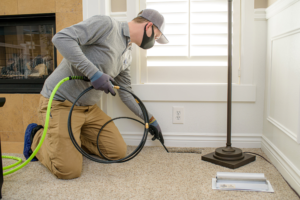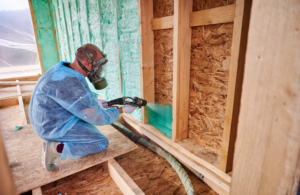Cleaning your home’s air ducts improves indoor air quality and can help reduce allergies, asthma, and other respiratory problems. It can also lower energy consumption and prevent mold and mildew.
To ensure your air ducts are cleaned properly, look for professionals who follow NADCA standards. Ask if they use a chemical biocide or ozone to kill bacteria, fungi, and other microbes in the ductwork. Contact Air Duct Cleaning Utah now!

Air duct cleaning is an important step in maintaining a healthy indoor environment. Poor-quality air in your home can cause a variety of irritations and symptoms, including sneezing, coughing, wheezing, dizziness, and headaches. The most common causes of poor air quality include dust mites, mold spores, pet dander, and bacteria.
Dirty air ducts can cause allergens to circulate throughout the house, which can trigger allergies and asthma attacks in people who suffer from these conditions. This is because the dust mites, pollen, and pet dander that collect in the ductwork can release their spores into the air when your system turns on. As a result, the spores can irritate the mucous membranes of the nose and throat, which can lead to itchy eyes, runny nose, and clogged sinuses.
Additionally, mold and mildew can also grow in your air ducts, which can create a musty smell throughout the house. Air duct cleaning is the best way to get rid of these contaminants and eliminate the odor.
It’s no secret that pollen, dust mites, and other allergens can trigger allergy symptoms in millions of Americans. These allergens can be released into your home from outside, on your clothes and shoes, or even by your pets. Once they’re inside, they can settle on surfaces and become airborne, triggering sneezing, itchy eyes, and other symptoms.
Fortunately, duct cleaning can help reduce these problems. The professional technicians who perform this service can remove the dirt, dust, pollen, pet dander, and other debris that accumulates in your air ducts. The professionals can also clean your furnace filters, heating and cooling coils, fan motor, and drip pans.
Air duct cleaning can help reduce histamine intolerance, which is a condition that can cause watery eyes, runny nose, itching, and breathing problems. This is because histamine intolerance can be caused by long-term exposure to toxic mold, which can be found in dirty air ducts. Long-term exposure to toxic mold can also lead to cognitive complications, such as memory loss, depression, and confusion. Air duct cleaning can help alleviate these symptoms by removing the toxic mold from your ductwork.
Reduces Energy Consumption
Dirty ductwork makes your HVAC system work harder than it should to maintain the desired temperature in your home. This causes it to consume more energy than necessary, resulting in high electricity bills. A thorough duct cleaning will remove the debris that restricts air flow, so your system can run efficiently again. This can result in lower electric bills, and it may also prolong the life of your furnace and air conditioner.
A dirty air duct can negatively affect your indoor air quality and cause respiratory problems, including asthma. If someone in your household suffers from asthma or other respiratory conditions, it’s important to have your ductwork cleaned regularly to prevent further irritation and discomfort.
Accumulated dirt, dust, and other debris can cause your ductwork to lose efficiency over time. The weakened airflow can make your heating and cooling system work overtime to achieve your desired temperature setting. This can cause your utility bills to skyrocket, and it may also shorten the lifespan of your HVAC equipment.
The EPA recommends that homeowners clean their ductwork at least every 10 years. However, it’s important to choose a reputable and experienced professional for this service. Some duct cleaning companies use chemical biocides or other treatment options to sanitize your ductwork and other system components. However, these chemicals can be dangerous to your family’s health, and they don’t always work effectively. A reputable company will carefully sweep your ductwork and ensure that all contaminants are removed, leaving it clean and free of debris.
Ducts that haven’t been cleaned in a while can be a fire risk, either by coming into contact with extremely hot surfaces or by igniting from a burst of static electricity. Having your ductwork professionally cleaned can help prevent fires, increase the durability of your system, and provide technicians with information that can help you identify other technical issues.
Air duct cleaning is one of the most overlooked maintenance tasks, but it offers many advantages that extend beyond simple cleanliness. If you want to experience these benefits for yourself, find a local NADCA member in your area and schedule an appointment today. Just remember that duct cleaners will need to access all rooms in your home, so make sure to clear a path for them before their arrival. You may also want to keep kids and pets away from the area.
Reduces Dust Buildup
The dust that accumulates in air ducts is a breeding ground for mold and bacteria. Over time, it also clogs air filters, forcing you to change them more frequently and costing money. A thorough cleaning will sweep the ducts free of this filth, helping you extend the lifespan of your air conditioning and heating systems.
Duct cleaning is often seen as a DIY task, but it’s not really a viable option unless you have the proper tools and experience. A specialized vacuum cleaner with a long hose is ideal, along with a brush or something that resembles a toilet brush to loosen the clumps of dust stuck to duct walls. It’s also important to wear heavy-duty gloves and a mask or respirator to prevent breathing in the dust.
It’s recommended to clean ducts regularly if you have pets, smoke in your home or suffer from allergies or other health conditions. Animal dander and other pollutants can build up in ducts over time, as well as toxins from rodents and mold. These contaminants circulate throughout your home, causing unpleasant odors and irritations.
If you’ve recently had water or fire damage in your house, it’s also a good idea to have your ducts cleaned as soon as possible. This ensures that any contaminants from the flood or fire are not continuing to circulate throughout your home.
Despite the many environmental benefits of duct cleaning, it’s important to understand that there is no universally accepted timeline for when this procedure should be performed. Rather, it’s up to homeowners to monitor their homes and identify the tell-tale signs that indicate a need for professional cleaning services. These indicators can include visible deposits of dust or mold on vents and registers, unexplained symptoms, and reduced comfort levels. By being attentive to these indicators, it’s easier to schedule regular cleanings based on individual needs.
Reduces Mold and Mildew
Mold spores can circulate throughout your home’s air ducts, especially if there is a leak or condensation buildup. If you suspect mold is growing in your ductwork, you should contact a professional who can sanitize and disinfect the contaminated areas. Mold can be dangerous and may cause health problems for those with allergies, asthma, or compromised immune systems. It is also a concern for pregnant women, children and elderly family members.
Dirty ducts aren’t just unpleasant to look at; they can also be a breeding ground for mold, mildew, and bacteria. These microorganisms thrive in damp, dark environments and can release spores into the air that you and your family breathe. If you see physical mold growth, have a musty odor, or are experiencing respiratory symptoms like itchy eyes and nose, you may have a problem with mold in your ductwork.
The good news is that regular duct cleaning can prevent moisture intrusion, clogging, and condensation buildup. It can also reduce dust and debris that can promote mold, mildew, and bacteria growth. It is also important to clean ductwork after major construction or renovation projects, as sawdust and other debris can infiltrate the system.
During an air duct cleaning service, professionals use specialized equipment to clean the vents, supply and return ducts, registers, grilles, diffusers, evaporator coils, heating and cooling coils, and fan motors. They can even clean the inside of your furnace and evaporator coils if necessary.
A home’s indoor air quality is a crucial part of overall well-being. Dirty ducts that circulate polluted air can trigger or worsen allergy and respiratory symptoms in those with sensitivities, auto-immune diseases, asthma, or chronic sinusitis. This can lead to irritated eyes, runny nose, itchy skin, and headaches. Regular duct cleaning can reduce the likelihood of these issues, making it easier to enjoy your home and improve overall household productivity. Those with young kids, seniors, or those with pre-existing conditions should consider scheduling air duct cleaning services on a regular basis to minimize their risk of complications. They should also talk to their doctors about incorporating regular cleaning services into their treatment plan.
